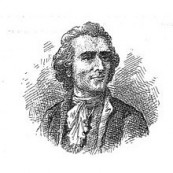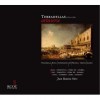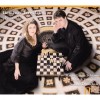传记
Domènec Terradellas (baptized, Barcelona 13 February 1711 – Rome 20 May 1751) was a Spanish opera composer, although all his works were thoroughly Italian in style. Born in Barcelona, the son of a day laborer, his early musical training is unknown. It has been said that Terradellas studied with the composer Francisco Valls in Barcelona, but Carreras i Bulbena did considerable research in Barcelona and found no evidence of this. On May 23, 1732 he entered in Naples as a student in the Conservatorio dei Poveri di Gesù Cristo. He studied composition with the famous Neapolitan composer, Francesco Durante.
Terradellas was one of a group of foreign-born composers who studied in Italy and adopted the Italian style. The reason for this is that Italian opera was by far the dominant genre of opera at this time, attracting composers from all across Europe: (George Frederick Handel, Johann Adolf Hasse, Johann Christian Bach (all Germans), Thomas Augustine Arne (an Englishman), Josef Myslivecek (a Czech), and Vicente Martin (a Spaniard).
His first work, an oratorio, Giuseppe Riconosciuto , with text by Metastasio was first performed in Naples in 1736. The musicologist, Felipe Pedrell, reported seeing the MS in the library of San Giacomo in Rome in 1898. The library was catalogued shortly after his visit, but when he returned in 1902, the score was missing and was not listed in the catalogue. This was probably a student work, because a note in the archives, dated May, 1736, states that "Il figliolo Terradellas è sempre in conservatorio" (Terradellas is still (a student) at the conservatory.) Terradellas's first opera was Astarto was performed at Rome in 1739 during the Carnival season. He may have collaborated with Gaetano Latilla on an opera Romolo, performed in Naples during the same year, but the libretto names only Latilla as the composer.
A serenata, La Cerere was performed in Rome in 1740, probably privately for a group of clergymen, and the three-act comic opera, Gl'intrichi delle cantarine, was performed in Naples during the same season. Carreras does not mention Cerere, but the libretto in the Library of Congress, Washington D.C., attests to Terradellas's authorship and the date of performance. Carreras also mentions operas for which no documentation has been found. The operas are Artemesia, said to have been performed in Rome in 1739, and Issipile, supposedly performed in Florence in 1742.
San Giacomo e San Ildefonso degli Spanuoli is a church established for Spanish residents in Rome. This church was already quite old in 1743, because Spaniards had been coming to Rome for centuries. Terradellas was approved as Maestro di Capella by the congregation of that church on May 1, 1743 with a salary of 10 scudi per month. During his tenure, he composed at least four masses, a half dozen motets, as well as other short works for the service. Later, trouble developed between Terradellas and one of his subordinates, and Terradellas was dismissed in August, 1745 after two years and three months.
His opera, La Merope, was performed during the Carnival of 1743. Alfred Loewenberg, in the Annals of Opera lists three other performances of this opera, but provides no documentation. The dates given are Florence, Carnival of 1743 and revived there December 26, 1749; Livorno during the Carnival of 1744; and Ancona during the Carnival of 1746. Since there are two extant MSS of this opera, it seems quite likely that there was at least one other performance. A libretto in the Library of Santa Cecilia names Terradellas as the composer of a Merope, performed in Florence in 1750, but the attribution is only written in pencil on the flyleaf facing the title page. Comparison of this libretto with that of 1743 casts serious doubt on its authenticity. The 1750 libretto has 22 arias, only five of which have the same text as the arias in the 1743 libretto.
During the Carnival of 1744, his Artaserse was performed in Venice. Loewenberg states that this opera was given on several other Italian stages, but no documentation has been found. The manuscript in Venice is dated 1744.








